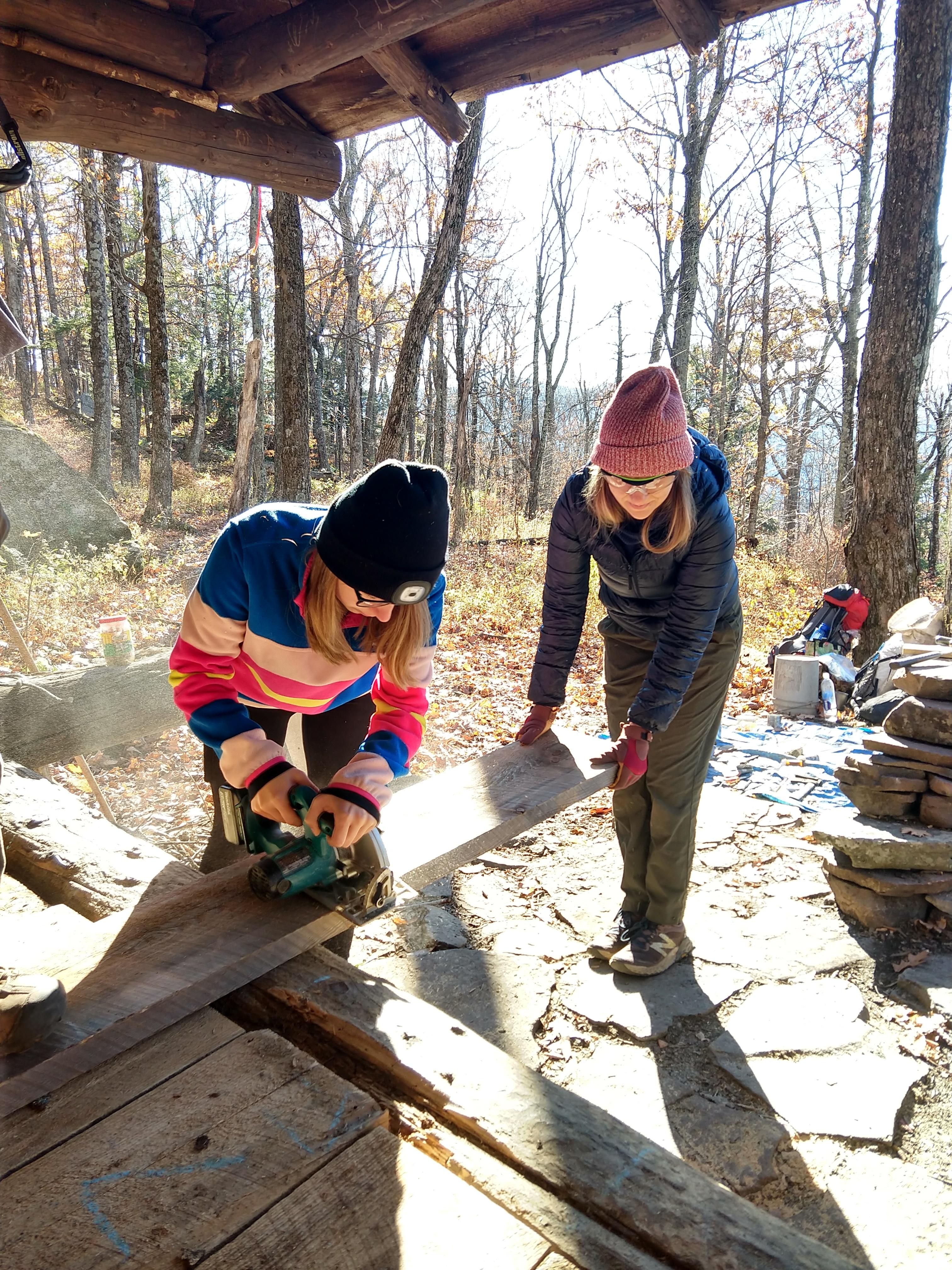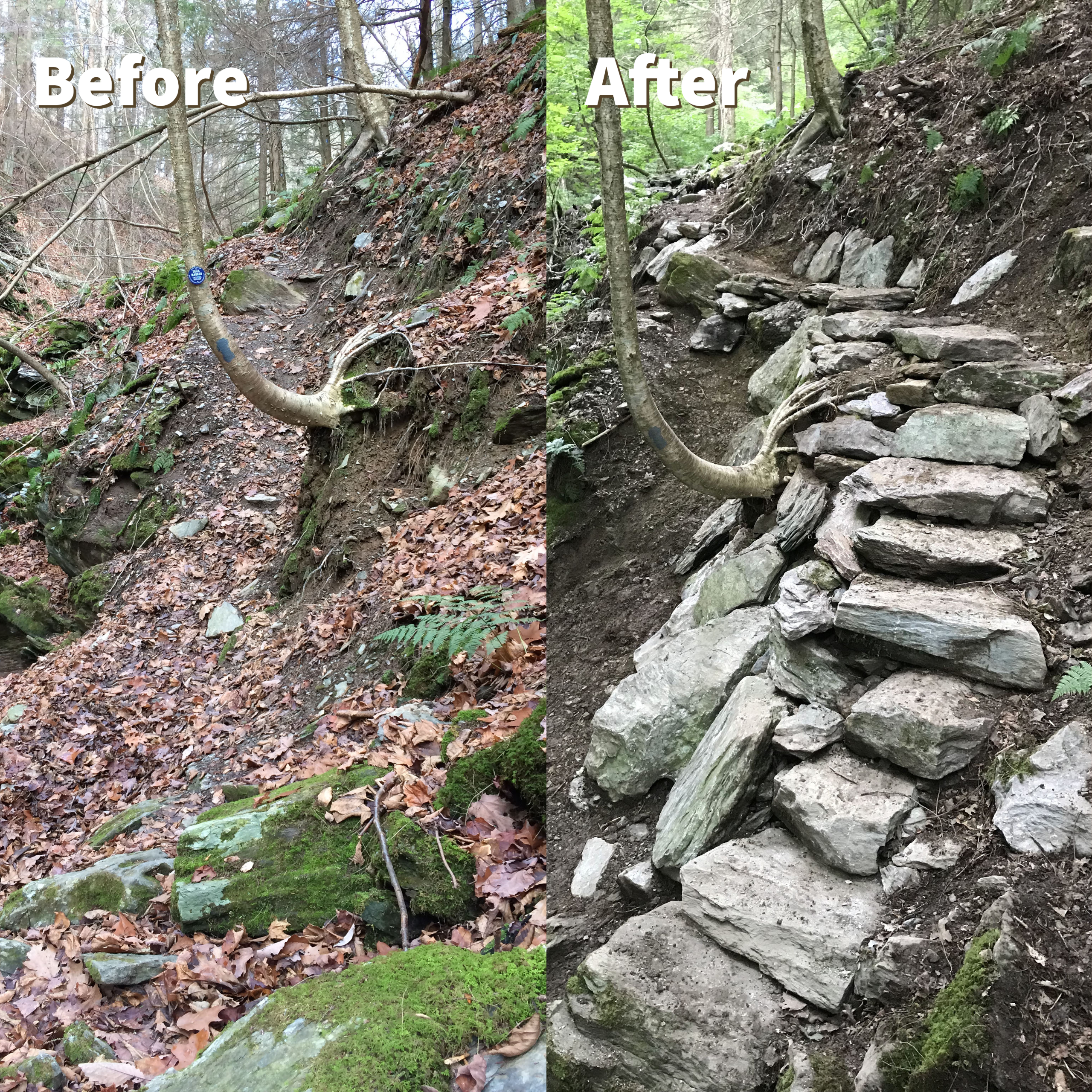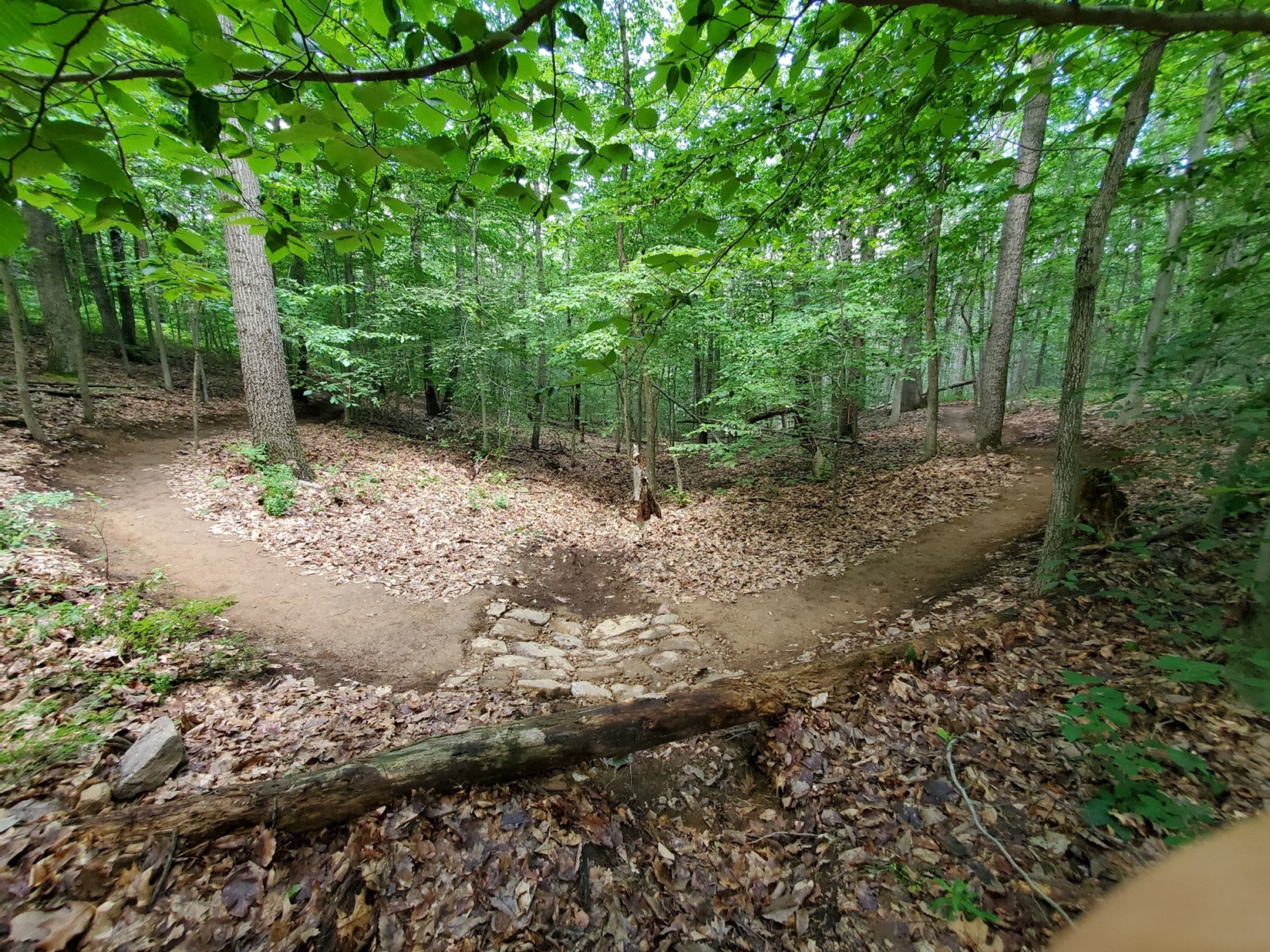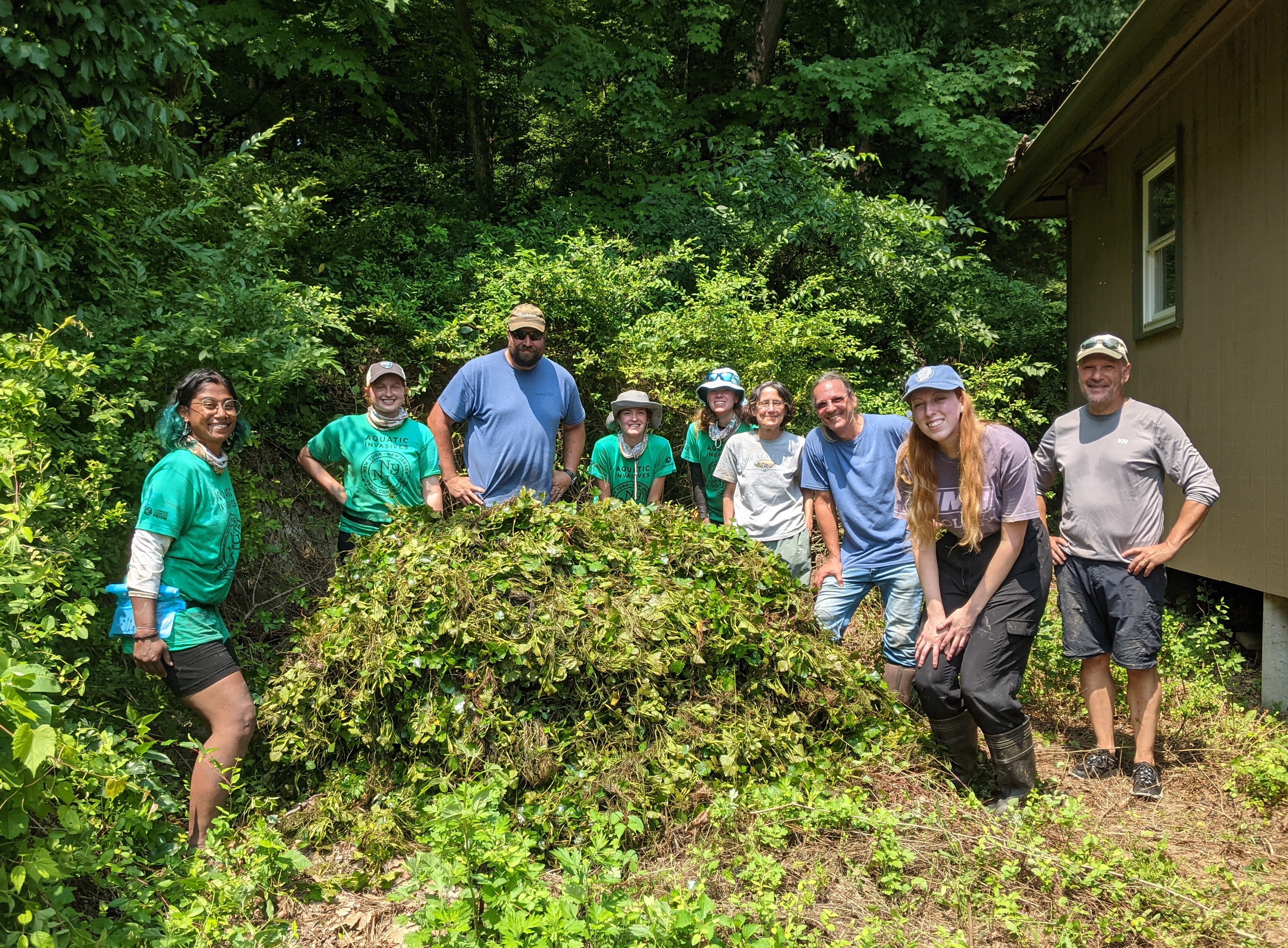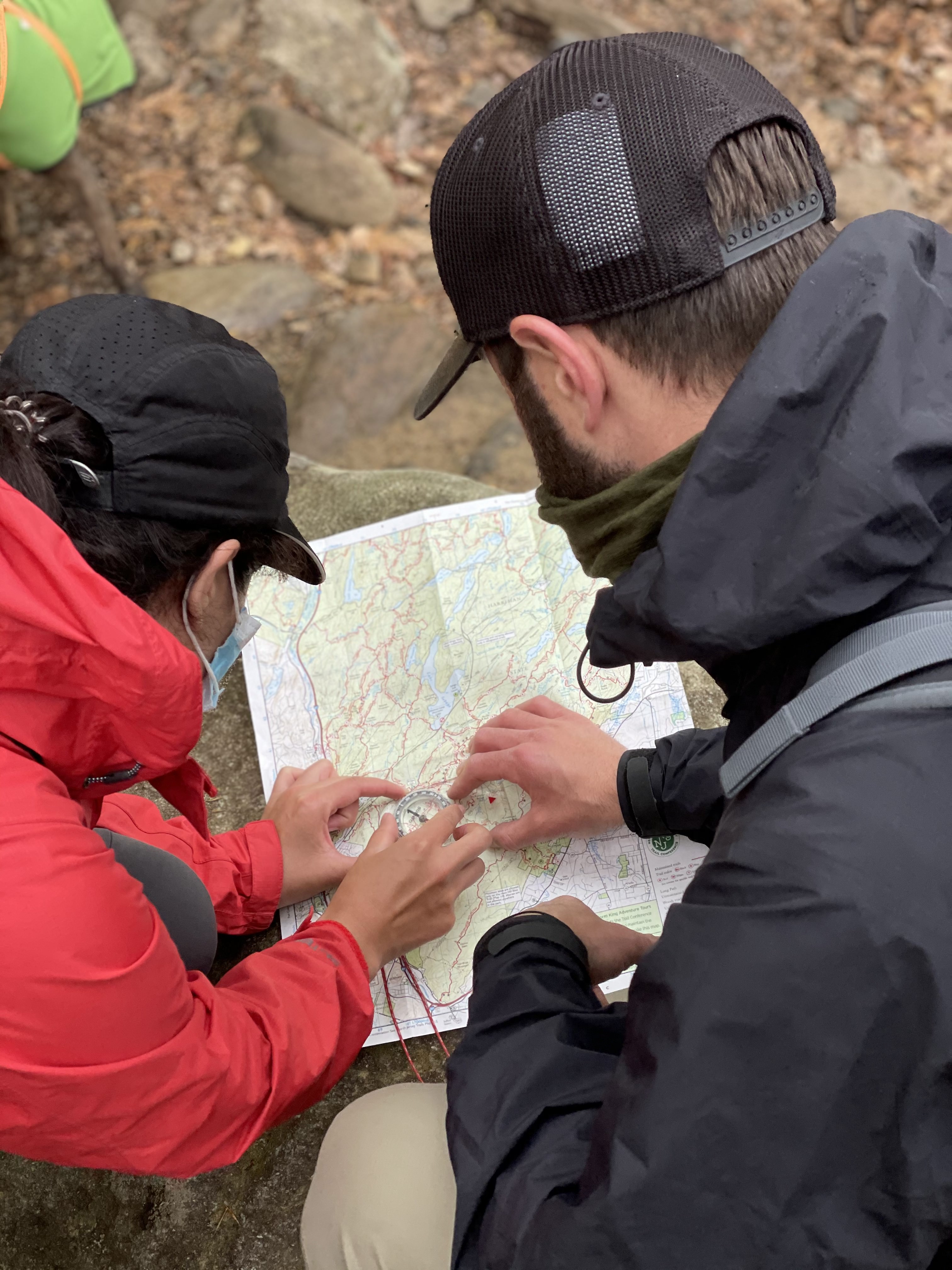
2021 Look Back, 2022 Look Ahead
Title
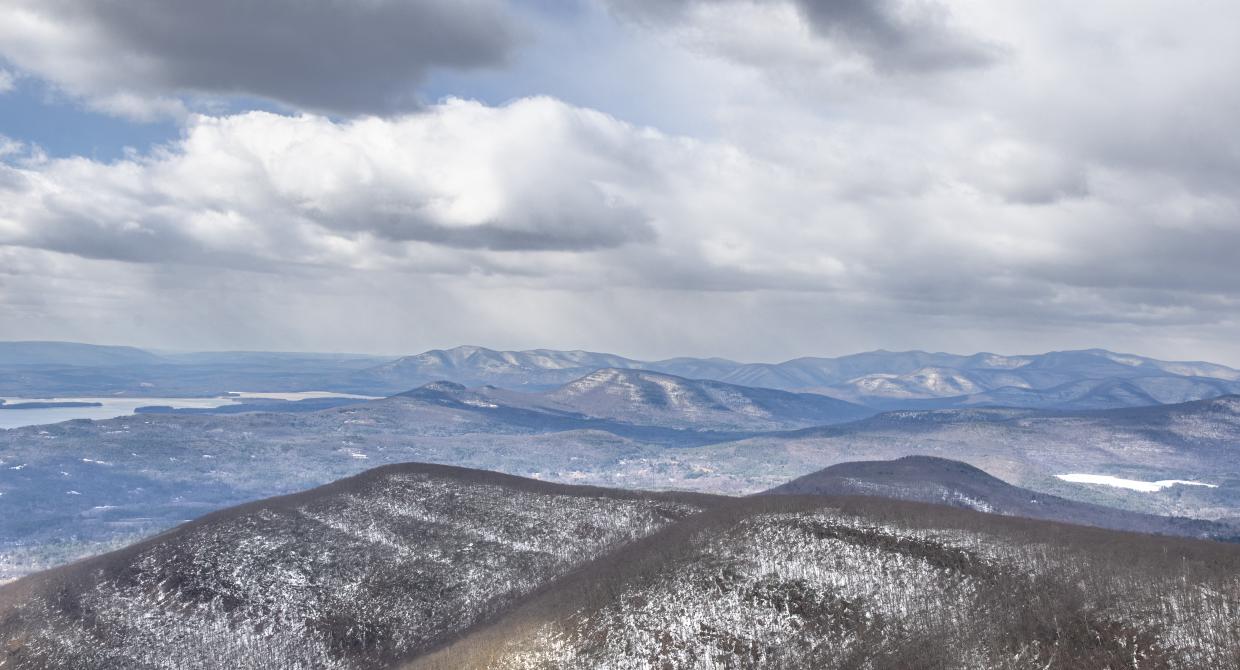
Body
As we close 2021 and look forward to a new year, we send our gratitude to the trail community and all who believe in the power of nature.
Thanks to you, the Trail Conference continues to be an incredible force multiplier, recruiting and training more than 2,500 volunteers who care for and protect our region’s natural areas and the trails that provide access to them. Our volunteers’ efforts result in approximately $3 million in labor given to the improvement of public lands annually. That’s $3 million of care given to local trails and parks to ensure your experiences outdoors are safe and enjoyable.
In 2021, the Trail Conference celebrated a century of providing that service to our friends, neighbors, and all who recreate on these lands. The pandemic continued to create unprecedented circumstances and challenges for the trails and our service community, yet we persevered. Although our headquarters remains closed to the public, our programs and operations found renewed success in a hybrid model of outdoor, in-person workshops and work trips while continuing to leverage our Online Learning Library and holding virtual meetings. At the same time, we have continued to see trails face remarkably high usage with millions of people seeking respite outdoors. Despite these challenges, our Trail Family demonstrated resilience. We had many great successes this year.
You’ll find these wins for the outdoors—from conserving critical land and trail access in New Jersey, to helping lead efforts to stop the dreaded spotted lanternfly in New York. As we look back on the 2021 successes we’ve had in improving access to nature, we look forward to 2022 and the ways we can use what we have learned to become a stronger, more impactful organization. Whatever the new year brings, we’re excited to continue this journey with you and grateful to have you along with us.
Trail Conference Town Hall: Feb. 2, 2022
Join Executive Director Josh Howard for a town hall update on the Trail Conference on Wednesday, Feb. 2, at 7:30 p.m. During this town hall, you'll hear more about these wins for the outdoors. In addition to celebrating our successes, Josh will discuss our plans for 2022 and the ways we can use what we have learned to become a stronger, more impactful organization.
2021 Highlights:
2022 Look Ahead
Engagement Program
This season, we put an emphasis on volunteer leader recruitment and onboarding. So far, 21 new leaders (15 Trail Supervisors, five Trail Chairs, and one ISF Crew Leader) were placed and received an individualized onboarding. Previous years saw the following number of new leaders placed:
- 2020: 11 new leaders
- 2019: 11 new leaders
- 2018: 10 new leaders
Note: The numbers reflect individuals placed, including co-leaders, not regions filled. We also recruited and trained 54 new Invasives Strike Force Surveyors, 265 Trail Maintainers, six Trail Stewards, five Appalachian Trail Corridor Monitors, and five Shelter Caretakers.
Training (Digital and In-Person)
Our volunteers, Corps, and staff held 43 live workshops to train volunteers in 2021. Additionally, we continued to leverage on-demand digital content in 2021 to train new volunteers. So far, we have trained 147 Trail Maintainers with our prerecorded Trail Maintenance Workshop.We launched a successful new initiative this season to deploy Corps crews to fulfill volunteer leader projects. Six volunteer leaders had one or two Corps crews come out to help execute projects— from removing invasives to building stone stairs to installing water bars. The feedback we received was all positive, including:
- “This program allowed us to address longstanding water problems on one of our trails, which we have previously been unable to find a crew to address.”
- “We are grateful for the exceptional work they did. They exceeded our expectations by helping us clear a 5,000-square foot section of trail of Japanese barberry and multiflora rose. And, they said they enjoyed it!”
- “Today was a huge success! I wish all my workdays were as productive as today.”
Online reporting for individual trail volunteers entered a trial phase in November, which is expected to run through mid-April. Five supervisor regions and one corridor manager region were selected to participate in the trial. The goal is to have a full launch in July 2022.
Trail Program
Catskills
- Baldwin Memorial Lean-to improvements: In addition to rebuilding the lean-to floor, the shelter’s accompanying privy, which had fallen into disarray over the past few years, was also rehabbed. Long-time Trail Conference shelter caretaker, Eric Friedman, in coordination with the DEC, stepped into action using his years of carpentry experience to bring the privy back to working condition. With support from Trail Conference staff, Eric rallied the help of a group of volunteers, along with staff and interns from DEC, to carry in approximately 280 pounds of materials, tools, and supplies for a four-day work trip. Although Eric camped out in the lean-to for the full trip, new volunteers hiked up to the site every day to help get the job done.
- Biscuit Brook privy rehab and relocation
- Echo Lake Lean-to fireplace rebuild
- Willowemoc Wild Forest trail improvements
- Restoring access to the Perkins Trail: Following heavy rainstorms, the bridge near Glenwood Road on the Perkins Trail in Fahnestock State Park was washed out. The stream was nearly impossible to cross during high water. To fix the crossing and regain access to trails in this area of the park, volunteer Trail Supervisor John Magerlein led a group of volunteers and members of park staff to place very large stepping stones in the stream.
- New Oscawana Ridge Trail: In August, a Trail Conference volunteer crew completed the new Oscawana Ridge Trail in the southern part of the park near Oscawana Lake. The 2-mile trail, which permits only foot traffic, may be reached by parking at the north end of Bell Hollow Road where it enters the park.
- Nurian Trail improvements: The bridge crossing the Ramapo River on the Nurian Trail had become very dangerous after most of the planks had rotted away. The West Hudson South Trail Crew completed a project this summer to replace the many broken planks on the bridge to ensure a safe crossing for hikers.
- Harriman Conservation Corps Crew: The 2021 TCCC Harriman Crew focused their efforts this year on restoration work on Harriman’s RamapoDunderberg and Triangle trails. The RamapoDunderberg Trail is very popular with hikers and backpackers, in part due to the trailhead’s proximity to the Tuxedo train station; this trail is also 100 years old and the first-ever built trail in Harriman. It was in definite need of improvements. The beginning section was braided with social trails due to sections of rock staircases becoming unusable. Before this season’s improvements, this section of trail had flooded significantly, even with light rain. Most notably, the crew completed the welcoming new stairway at the entrance to the Ramapo-Dunderberg Trail. Improvements on the Triangle Trail included installing water bars to improve drainage, setting stone stairs, and setting stepping stones across a river.
- Highlights:
- 1.4 miles total trail improved (Triangle and Ramapo-Dunderberg trails)
- 200 linear feet trail rerouted
- 46 new stone stairs installed
- 24 stone stairs repaired/ improved
- 11 step stones installed
- 7.5 square feet stone crib wall constructed
- 12 drainage structures constructed or restored
- 250 feet of trail renaturalized
- Highlights:
Hook Mountain/Nyack Beach State Park
- Upper Nyack Trail construction: The new and improved Upper Nyack Trail was opened to the public in June. Though less than a mile in length, the technical work required to build a safe, sustainable route through such challenging conditions took almost 2 years to complete. The Long Distance Trails Crew installed 351 stone steps, built 2,537 square feet of crib wall, and constructed 3,775 feet of sidehilled trail to complete the project.
Hudson Highlands State Park Preserve
- Taconic Conservation Corps Crew: The 2021 TCCC Taconic Crew worked on multiple projects in Hudson Highlands State Park Preserve. The crew completed the Washburn Trail reroute, which concluded 2 years of work by the Trail Conference Conservation Corps. This project involved substantial trail improvements along a one-third-mile stretch of trail leading up from the old quarry to the Cold Spring overlook. This section of trail had become extremely eroded with poor trail tread definition in part due to very high traffic volumes. Many improvements were made on the Wilkinson Memorial Trail, which included closing 212 feet of social trail, installing drainage features along the trail, and repairing and building multiple staircases, stepping stones, headwall, and new tread surfaces. The Taconic Crew also completed the Undercliff Trail reroute, which Crew Leader Snowden Jones called “one of the most difficult but exciting projects this season.” The goal of this 4-year project is to connect the Undercliff Trail to the Breakneck Ridge Trail, giving hikers an option to take a shorter loop around Breakneck instead of continuing on the final stretch of the challenging scramble. The crew faced some challenges, including Hurricanes Ida and Henri stalling work due to muddy conditions making it difficult to set stone stairs. Nevertheless, the crew achieved their goal of completing two trail projects before the end of the season.
- Highlights:
- 0.7 miles total trail improved (Wilkinson Memorial and Undercliff)
- 110 linear feet of trail rerouted
- 61 stone steps installed
- 4 stone steps repaired
- 3 stepping stones installed
- 32 square feet retaining wall constructed
- 13 drainage structures constructed or restored
- 875 feet of trail renaturalized
- Highlights:
Minnewaska State Park Preserve
- The Mossy Glen Trail is historically wet and has several drainage issues. The Hudson Nor’westers Trail Crew spent much of the 2021 season making improvements to the trail, including stepping stones, water bars, and treadway enhancements in wet areas.
- The Wolf Brook bridge in the Neversink River Unique Area had been in need of repairs. It is essential in wet seasons for access to the Blue Trail East. Trail Supervisor Lou Baldanza, with help from other volunteers, led a work trip to repair the bridge and improve access to the trails south of the brook.
- Palisades Conservation Corps Crew: The 2021 Palisades Crew consisted of four TCCC members working in Sterling Forest State Park along the McKeags Meadow Loop and McKeags Connector trails. Significant work has been put into building a network of multi-use trails in this park over the past few years; this year’s crew contributed to the efforts. The crew improved 0.4 miles of these trails with 165 linear feet of stone turnpike, 55 square feet of crib wall, and the construction of five drainage structures. The Palisades Crew had a robust group of volunteers, which included several friendly returnees who proved to be essential to the project’s progress. Palisades Crew Leader Bob Delap appreciated the help and said, “It really can’t be overstated how useful the eager hands of a volunteer can be. Thanks to those who turned out for us.” The crew faced some challenges, including a stretch of oppressively hot weather. Despite the setbacks, the crew kept their morale high and made excellent progress on the trail this year. When fully opened, the loop is sure to be an enjoyable option for hikers and the mountain biking community.
- Highlights:
- 0.4 miles total trail improved (McKeags Connector and McKeags Meadow Loop)
- 1,981 linear feet of trail rerouted
- 165 linear feet of stone turnpike
- 55 square feet of crib wall
- 5 drainage structures constructed
- Highlights:
- The Bash Bish Trail Crew, led by Crew Leader Andrew Seirup, recently completed several projects over the course of 3 years to tackle issues and improve the experience for users on the Cedar Brook Trail.
- Quarry Trail Improvements: The Bash Bish Trail Crew worked on rerouting and improving a particularly eroded and steep section of the challenging Quarry Trail in Taconic State Park. The crew worked to install stone steps and create a more sustainable reroute of the trail around a challenging rock scramble.
Westchester County
- The Trail Tramps continue to work on the Briarcliff Peekskill Trail
- Relocated the intersection of the Ernest Walter and State Line trails to allow the Ernest Walker to follow a more sustainable route and to improve hiker navigation.
- Relocated the start of the Winnebago Trail to reduce instances of lost hikers entering a neighboring Scout camp.
- Extended the red-blazed Durham Trail. It now ends at the blue-blazed Splitrock Loop Trail.
- Adopted the Orange Trail at the north end of Splitrock Reservoir. This trail offers scenic views and facilitates loop hikes.
- Iris Trail bridge repair
- West Jersey Trail Crew rerouted a section of the Mashipacong Trail from a badly eroded road drain to a more sustainable, walkable alignment.
- The West Jersey Trail Crew created a new extension to the Orchard Trail, facilitating its role in the new Solar Walk recently installed in the park by the adjacent amateur astronomy club.
Morristown National Historical Park
- Volunteer leaders Bob Jonas and Estelle Anderson created a roving trail crew dubbed the Clipping Brigade. They tackle the park’s trails most in need of care at any given time. As of September, the crew had already gone out on nine work trips to address invasive plant overgrowth encroaching on the trails.
Morris County
- Pyramid Mountain Natural Historic Area:
- Reconfigured trails in all three sections of the park to prevent hikers from wandering into neighboring housing developments far from the parking lots. To keep visitors on the trails, two loops in the Turkey Mt. and Pyramid Mt. sections were created by connecting existing trails, accomplished over one week in March.
- An Eagle Scout installed signs throughout the park with improved directions to popular features and the main parking lot on Boonton Avenue.
- Volunteer trail maintainers have helped keep up with crowds of visitors—many novice hikers—which has been a goal of both the park commission and the Trail Conference.
Morris Conservation Corps Crew
- The 2021 TCCC Morris Crew worked on trail improvement projects in multiple Morris County parks. The crew worked on the Green Trail in Lewis Morris County Park in Morristown and the Blue Trail in Pyramid Mountain Natural Historic Area in Montville. The goal of the Lewis Morris project was to reroute a section of the Green Trail that had several problems. Issues included erosion damage due to steep trail grades and trail braiding as a result of the tread not properly providing a durable and defined surface for users. In this case, the problems of the original trail were too extensive to mitigate. Rerouting the trail was the best solution. The scope of the Pyramid Mountain project was to reroute sections of the Blue Trail that are suffering from issues like erosion, undefined tread, braiding, and hard-to-navigate sections of boulder scramble. Our crew is constructing a reroute of the Blue Trail that will connect from the Orange Trail on the southwest end of the mountain to the Yellow-Dot and Blue-Dot trails, getting hikers to an overlook and near points of interest such as Tripod Rock. The crew has been grateful to have an enthusiastic volunteer participate in workdays. Throughout the season, this crew was met with challenges that interfered with the goal of completing the reroute by the end of the season. They remained hard-working. Though they were down a crew member beginning mid-July and their crew leader faced an injury toward the end of the season, the crew nearly completed the reroute, which next season’s Corps members will take on to complete. Highlights: 0.75 miles of trail improved (Lewis Morris: Green Trail; Pyramid Mountain: Blue Trail) 3,944 linear feet of trail rerouted 30 stone steps constructed 21 square feet stone retaining wall constructed 19 linear feet of turnpike built 2 drainage structures installed 125 linear feet of trail closed/renaturalized
- MEVO Trail Crew rerouted over 700 feet of trail to improve the hiking experience and sustainability of the recently blazed Lake Sonoma Loop.
Ramapo Valley County Reservation
- MEVO Trail Crew improved the popular Reservoir Loop by elevating a 60-foot section of trail tread above a perennial wet area. This involved creating a variety of technical trail structures—including a retaining wall, drainage lenses, and cross drains.
- West Jersey Trail Crew installed two larger stone step stream crossings on the Deep Root Trail.
- West Jersey Trail Crew installed step stones along the Stony Brook Trail.
- West Jersey Trail Crew installed a cribbed timber staircase on the Grist Mill Trail.
- Relocated the intersection of the Terrace Pond Red and Terrace Pond North trails due to beaver dam flooding.
- The West Jersey Trail Crew replaced a missing puncheon “bridge” on the Appalachian Trail near Long House Drive.
- In partnership with the New Jersey Department of Environmental Protection (NJDEP) and Appalachian Trail Conservancy (ATC), the Trail Conference spearheaded the revitalization of kiosk signage along the Appalachian Trail at the popular Pochuck Boardwalk.
Wildcat Ridge Wildlife Management Area
- Jersey Off-Road Bicycle Association (JORBA) and the Trail Conference collaborated on a much-needed bridge replacement on the Splitrock Loop Trail.
Outreach and Education
For nearly a decade, the Trail Conference has joined with land managers and local partners to provide training, management, and oversight to several Trail Steward programs at multiple trailheads and summits in New Jersey and New York. Trail Stewards help to protect the trails, the environment, and the visitor experience and promote local communities—a vital job in 2021 as more people than ever before began to explore trails throughout the region- Trail Conference Volunteer Stewards and Stewards working for other environmental organizations trained by the Trail Conference provided Steward presence in Hudson Highlands State Park Preserve, Fahnestock State Park, the Ashokan Rail Trail, and several NJ DEP parks. The visitor count at the Ashokan Rail Trail from January to October was more than 200,000 people.
Conservation Corps Accomplishments
- The Trail Conference Conservation Corps Trail Steward program trained 18 AmeriCorps members to serve in the Hudson Valley and the Catskills in 2021. Locations included Hudson Highlands State Park Preserve, Fahnestock State Park, the Appalachian Trail at Bear Mountain State Park, the Croton Gorge Unique Area at the Old Croton Aqueduct, Minnewaska State Park Preserve, the Sam’s Point area of Minnewaska, and several summits in the Catskills. From May to October, Corps Stewards engaged over 50,000 trail users. They are key in protecting the ecological integrity of these special places being threatened by issues such as misuse and high usage.
- The third edition of Walkable Westchester, the completely revised and improved guide to more than 225 parks and 635 miles of trails in Westchester County, was a record-breaking hit after arriving in early 2021.
- So was the eighth edition of our Delaware Water Gap & Kittatinny Trails map set, which covers more than 325 miles of trails along the Kittatinny Ridge and adjacent Delaware River in three states.
- The much-anticipated new Northern New Jersey Highlands Trails maps arrived in December in print and digital Avenza Maps app formats.
- Additionally, Reflections, the 100th-anniversary book recounting the Trail Conference’s first century of service, was published in time for our Centennial Gala. Read more about both publications and how to get your copies on page 16.
Ecological Stewardship Program
Training and Education Resources
- Our Ecological Stewardship team created 30 new educational videos that have received over 21,000 views on YouTube for an additional 2,000 hours of viewed content by our volunteers this year. Our Ecological Stewardship team also presented 42 informational webinars and led guided invasives walks to educate the public about invasive species. These events were attended by over 1,900 participants.
- The Invasives Strike Force Plant Survey season officially wrapped up at the end of October and the final numbers are incredible! This year, we had 149 volunteers dedicate over 1,700 hours to searching for and reporting invasive plants along 142 trail sections in our region’s natural areas. Altogether, this included greater than 240 miles of trail surveyed: approximately the distance between New York City and Washington, D.C.! These hours and committed efforts are on par with the record-breaking production of the 2020 survey season.
- Our Ecological Stewardship team, together with our dedicated community partners, agencies, and volunteers, have continued in earnest with our Spotted Lanternfly (SLF) early detection and rapid response efforts. Our all-new Spot the Spotted Lanternfly program engaged 134 volunteers who dedicated over 850 hours to surveying for spotted lanternfly adults and egg masses across 289 distinct survey locations in the Lower Hudson Valley and northern New Jersey. We also led 12 SLFspecific workdays that engaged 97 different volunteers. They dedicated approximately 400 hours to erecting insect traps on species of trees that SLF is attracted to, clearing vines and other vegetation for easier access for our management team, and squashing any SLF they found. Altogether, we installed 166 SLF traps across 11 different parks/townships in known infestation areas in the Lower Hudson PRISM region. These traps were regularly checked by volunteers and staff and enabled us to remove over 8,500 adult and young spotted lanternflies. An additional 700 egg masses were removed from the environment by volunteers. In addition to these manual removal efforts, we also treated hundreds of the SLF’s host tree, tree-of-heaven (Ailanthus altissima), with insecticide so that any SLF feeding on these trees were killed or weakened. This multi-faceted and cooperative effort to control such an economically and environmentally damaging species highlights our leadership as the go-to resource for invasives management in our region.
- In 2021, our Ecological Stewardship programs added an additional emphasis on ecological restoration and native plant reintroduction. With the help of volunteers from our Habitat Helpers Crew, our volunteers grew 23 different species of native plants to be introduced into strategically targeted natural areas. As a result, 1,276 native species were planted at four different restoration sites. Three of those sites were in Harriman State Park, where 892 native species were planted.
Conservation Dogs Accomplishments
- The Conservation Dogs program targeted eight species in 2021: six invasive plants (Scotch broom, sticky sage, kudzu, Chinese bush clover, crested late-summer mint), one invasive insect (spotted lanternfly), one invasive fungus (oak wilt), and a native species of concern in New York State (wood turtles). The team surveyed 414 acres for invasives, and over 7,700 invasive plants were treated. The Conservation Dogs program dedicated efforts to the early detection of spotted lanternfly by surveying 20 sites over 17 days for 61 hours.
- Four paws were added to the program with the introduction of Peat in November. Peat is an American Field Labrador born on Christmas Day 2020. He started working on his first species, Scotch broom, at only 9 months old! This goofy, hardworking, and ultra-motivated guy has a long career ahead of him. Peat is handled by Conservation Dogs Program Coordinator Arden Blumenthal.
- All the invasive species that our conservation dogs are trained to sniff out are not yet common in our region’s natural areas. So, early detection by the dogs, followed by rapid response removal efforts by our ISF Crew, can be carried out with the possible goal of full eradication at our target sites. It is the synergistic connections between our various programs and our focused efforts in inspiring a sense of shared responsibility for environmental protection that will continue to drive our Ecological Stewardship Program into 2022 and beyond.
Conservation Corps Crew Accomplishments
- From forests to meadows to suburban neighborhoods, the Terrestrial ISF Crew traveled across the Lower Hudson Valley to complete 35 projects to tackle emerging invasives, protect conservation targets, and restore natural areas. In total, they surveyed 420 acres, managed 112 acres, and removed over 100,000 invasive plants! Along the way, they made some unforgettable memories and forged unbreakable friendships. Work-related highlights were circulated throughout the season in newsletters and social media posts (find them at nynjtc.org and instagram.com/tcconservationcorps), so here are a few fun highlights: trying every flavor of Oreos currently available, feasting on potato cones while camping at Ward Pound Ridge Reservation, and spending long summer nights lakeside at Welch Trail Education Center!
- This was a banner year for the Aquatic Invasives Strike Force! Through their aquatic invasives monitoring and management program, the crew was able to survey 40 Hudson Valley lakes, ponds, and rivers (about 2,300 acres) for priority invasive plants and invertebrates. They found new reports of emerging species like fanwort and variable-leaf milfoil, young populations of water chestnut, and dreaded animal invaders like the zebra mussel and mystery snail, all of which help contribute to the understanding of the distribution of these species across the state and assist with informing management priorities. They also removed record numbers of water chestnut—almost 121,000 plants—from 13 sites with the help of nearly 50 amazing Trail Conference volunteers. The crew got to experience the success of their effort firsthand, with one site that has been managed since 2019 down to just 110 plants from the 27,000 removed three years ago. Prevention is key to stopping new invasions, and the crew helped to do just that by participating in the Watercraft Inspection Steward Program, educating over 800 boaters and anglers about AIS spread prevention and inspecting 450 boats, resulting in the interception of 11 invasive plants. Collaboration was a common theme for the crew this season as well. They teamed up with multiple partners and state agency leaders on AIS projects, such as post-treatment snorkeling for hydrilla in the Croton River with the NYS DEC; collecting water samples to potentially detect northern snakehead DNA in the Bashakill with the NYS DEC and the U.S. Fish and Wildlife Service; and monitoring snakehead through electrofishing surveys with DEC’s Region 1 Fisheries Unit. The AISF crew is managed, in part, by the LHPRISM Aquatic Invasive Species Program, hosted by Teatown Lake Reservation.
Conservation
- The Trail Conference is a lead partner in two grand-scale trail connectivity plans that seek to create green corridors, improve access to nature, and grow economic opportunities for trail towns. They are the Highlands West Trail Connectivity Plan (Orange County, N.Y.) and the Lake Hopatcong Regional Trails Plan (Morris County, N.J.).
- We worked with The Land Conservancy of New Jersey (TLC) to preserve two key parcels in New Jersey this year. In February, TLC announced the purchase of 40 acres of undeveloped land in Mahwah from the New Jersey Department of Transportation. This key parcel—important wildlife habitat and watershed—buffers 13,000 acres of county and state parkland that comprises the largest area of undeveloped land in Bergen County. Much of the land is rugged terrain and difficult for visitors to navigate, though its recreation potential— including a trail connecting Ramapo Mountain Preserve to New York State, through the village of Hillburn into Harriman State Park—is being assessed.
- Another 2.5 acres, nestled between Wawayanda State Park and Abram S. Hewitt State Forest, secure permanent public access for a trail through the property, which will also act as a buffer for sensitive wildlife habitats. The land purchase was completed by TLC in October with open space funds from the New Jersey Department of Environmental Protection, in partnership with the New York-New Jersey Trail Conference, Green Acres, and private donors. It will be donated to the State of New Jersey and become an addition to Wawayanda State Park. (See story.)
- In the spring, the Trail Conference acquired 113 acres of forested land in New York’s Shawangunk region in Orange County. This property connects Gobbler’s Knob State Forest with the Bashakill Wildlife Management Area and allows us to move another section of the coaligned Long Path and Shawangunk Ridge Trail (SRT) off the road, away from homes, and into the woods. Additionally, this parcel extends an already protected trail corridor to a length of 20 miles, permanently protecting both trails. The next step is to completely move the trail onto the protected land.
Look Ahead
In 2022, we will keep striving to inspire the next generation of trail users to become champions of the outdoors through user education, public participation, and sustainable, on-the-ground solutions.
- To meet the current demands on public lands, our volunteer force will continue to grow and be strengthened. Recruitment of both volunteers and Conservation Corps members in 2021 surpassed our expectations, with more people than ever before seeking opportunities to give back to nature. That includes the successful recruitment of several integral leadership positions. We will build on this success by launching an online reporting system and investing more energy and effort into our Trail University offerings.
- We will continue to collaborate with like-minded organizations to address challenges facing trails and equitable access to public lands. Whether it is in organized coalitions like the New Jersey Trails Council, Catskill Park Strategic Planning Advisory Group, and New York Outdoor Recreation Coalition, or project-based work sessions with partners like JORBA, Black Rock Forest, and the New Jersey Palisades Interstate Park Coalition, we will join forces with stakeholders to address issues such as overcrowding at trailheads and obstacles to diversity outdoors.
- By providing outreach and education, we can empower the public to know and experience the joys of nature and all its benefits. Our Trail Stewards and Ecological Stewards will serve at trailheads, summits, and boat launches throughout the region to assist and educate visitors. We will publish new trail maps and books and invest in new ways to engage people online to help them feel informed, safe, and prepared for the adventures that await them.

